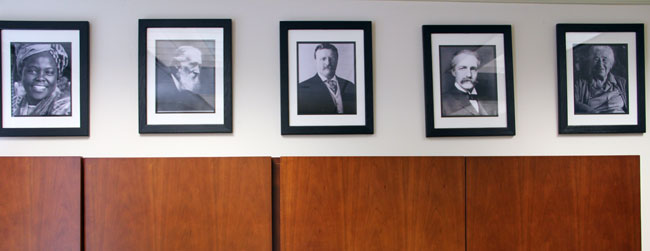Happy Earth Month! The first Earth Day took place on April 22, 1970 and was conceived as a national day of education and awareness at a time when our waterways, air and wilderness were being despoiled at an alarming rate. As people began to realize the topic was too big to be addressed within 24 short hours, what began as a day gradually became an entire month of education and awareness.
For me, Earth Month is a good time to think about the legacy that has been left to us and the legacy we are leaving to future generations. On the wall above my desk, I have a row of photos of some of my personal heroes from the conservation and environmental movements — visionaries and activists who have left a legacy of stewardship that calls to all of us.

There is John Muir, the Scottish-born, American naturalist and preservationist, who lived a life of adventure in his quest to better understand the workings of nature. He was a tireless advocate for the protection of the Yosemite Valley and other wild places and is widely recognized as the father of our national park system. Muir spent most of his later years advocating for the preservation of western forests.
“The clearest way into the universe is through a forest wilderness.” –John Muir
There is Teddy Roosevelt, the Republican war hero, outdoorsman and naturalist, who as president created 150 national forests, 51 federal bird reservations, 18 national monuments, five national parks and four national game preserves. During his presidency, he protected an astounding 230,000,000 acres.
“A people without children would face a hopeless future; a country without trees is almost as helpless.” –Theodore Roosevelt
There is Gifford Pinchot, the first chief of the USDA Forest Service, close friend of Teddy Roosevelt and later governor of Pennsylvania, who is seen as the “father” of American conservation because of his unrelenting efforts to protect America’s forests. Pinchot was frequently seen as an adversary to John Muir because he saw conservation in terms of managing the nation’s natural resources for long-term use, while Muir saw wilderness protection as an end in itself. While my heart is often with Muir, my head is with Pinchot, and they both share space on my wall (although not next to each other).
“The purpose of conservation: the greatest good to the greatest number of people for the longest time.” –Gifford Pinchot

There is Mardy Murie, a naturalist, conservationist and author, who was instrumental in the creation of the Arctic National Wildlife Refuge and the passage of the Wilderness Act. Murie spent her honeymoon with her husband, naturalist Olaus Murie, travelling by boat and dogsled in the wilderness of Northern Alaska, conducting research on the caribou. It was the beginning of a journey that would take her again and again into some of the most beautiful and wild places on Earth. In 1998, Murie received the Presidential Medal of Freedom, the highest civilian honor in the U.S. Her work continued until her death at age 101.
“I hope the United States of America is not so rich that she can afford to let these wildernesses pass by or so poor she cannot afford to keep them.” –Margaret “Mardy” Murie
And there is Wangari Maathai, a Kenyan professor of veterinary anatomy and leader of the National Council of Women of Kenya, who went on to found the African Greenbelt Movement, which focused on the nexus of tree planting, environmental conservation and women’s rights. Maathai introduced the idea of community-based tree planting as a means of empowerment, conservation and poverty reduction. She and the movement she created have assisted African women in the planting of more than 40 million trees. In 2004, Maathai became the first African woman to receive the Nobel Peace Prize.
“It’s the little things citizens do. That’s what will make the difference. My little thing is planting trees.” –Wangari Maathai
As we celebrate Earth Month, I invite you to think about two questions (and share your answers if you are willing!). First, who are your heroes and what is the legacy they have left us? And second, what are the little things you are doing to make a difference and leave a legacy of your own?